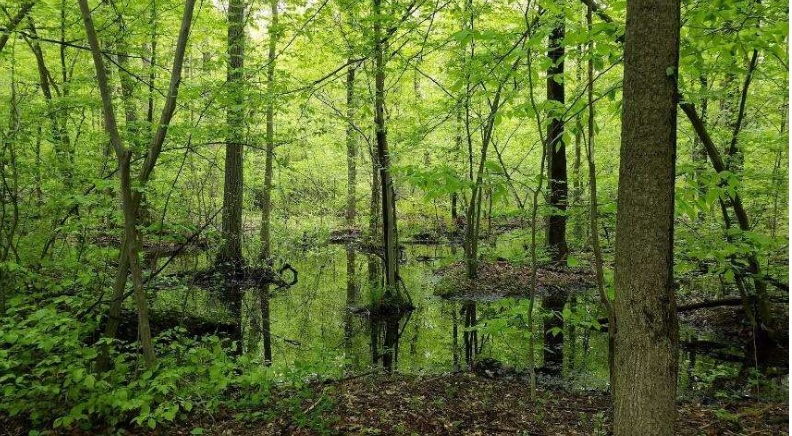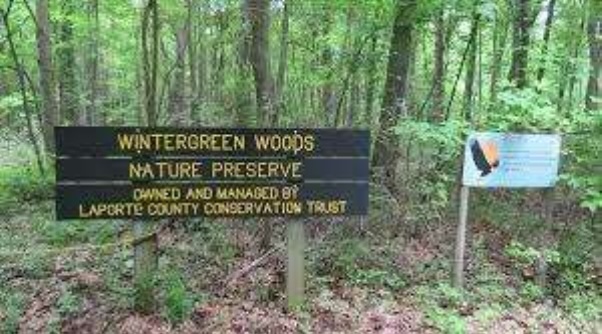Hoosier Foray
A spring foray is being planned for late April or early May. It is being planned for northwest Indiana in Laporte and Porter counties Specific dates and other details such as lodging, maps, etc. will be forthcoming, after discussion at the OMLA annual meeting.
It should be noted that this will be a special foray, it will not displace the annual summer or fall Ohio forays.
Introduction

Ambler Nature Preserve. This boreal flatwoods natural community is found nowhere else in Indiana.
It contains plants typically found much farther north. At least 39 state-listed plant species and many others
considered rare in the Chicago region are found here.
The foray will be in the Northwest Moraine Natural Region of Indiana. This is an area of high native plant diversity and a high percentage of rare plants. No other part of the state has such a diverse and rich flora.
This diversity is due to a number offactors: topographic relief, many niches and microclimates. It is also a region where three major ecological areas meet: prairie, eastern deciduous forest and northern boreal forest. The proximity of the cold waters of Lake Michigan help keep weather cooler, providing conditions for plants that normally live much further north to live in the area.
There are three sections of this natural region: a) Valparaiso Moraine characterized by high rolling hills and a large variety of soil types and textures in a relatively small area; b) Chicago Lake Plain characterized by flat poorly drained areas with sandy and mucky soils, and numerous different types of wetlands; c) Lake Michigan Border characterized by high dunes and wetlands. This is an interesting part of the state for sure.
Fortunately, even being relatively close to Chicago, many areas have been preserved. The foray will be looking at a number of these preserved areas, discussed below.
Potential sites for the Hoosier Foray
Laporte County
Ambler Nature Preserve. This is a large boreal flat woods, just south of Lake Michigan in Laporte County, with large areas of mature trees (area 500+ acres). Its flat poorly drained soils are of a coarser texture with numerous areas of vernal pools and areas with mature trees and hummocks with Sphagnum mosses in places. Trees include red maple, northern pin oak, black gum, tulip tree, and white pine.
Wintergreen and Sebert Nature Preserves. These are two much smaller areas within a few miles of Ambler Preserve.

They are in many ways similar to Ambler. Wintergreen is only 20+ acres. It is wet much of the year due to poorly drained soils. It is a mature forest with paper (white) birch as a common tree, with numerous large individuals scattered throughout the woods, along with American beech, basswood, red maple, and a variety of oaks. Sebert seems drier and has some open sandy areas and numerous small wetlands. It is 40+ acres. Both are boreal flatwoods with hundreds of native plants including a number of threatened and rare plants.

Sebert Woods Nature Preserve
Little Calumet Headwaters Nature Preserve
This area protects some of the headwaters of the Little Calumet River. It contains seeps, spring runs, and upland forest. It is 100+ acres.

Two views of Little Calumet Headwaters Nature Preserve
Porter County
Moraine Nature Preserve
There are three areas of this large preserve that will be looked at: a) an upland forested gorge complex, whose mature forested gorges have numerous erratics and boulders; b) a calcareous fen and forested kame area; c) a large mature oak-hickory forest tract added to preserve from the University of Chicago, sharing part of a bog with adjoining property.
John Merle Coulter Nature Preserve
This state-dedicated nature preserve of 80+ acres features a complex of sand prairie, oak savanna, and wetlands. More than 400 species of plants have been identified, many of them state-listed. This preserve is adjacent to Indiana Dunes National Park and Indiana Dunes State Park. Although the parks have been studied intensively, this preserve is fairly new and has no bryophyte or lichen records yet.
Logistics
While more details will be coming soon, they will be first discussed at the annual meeting. Motels are plentiful in the area and range from budget to higher end establishments. Indiana Department of Natural Resources (IDNR) has offered space to meet and set up scopes at Moraine Nature Preserve, north of Valparaiso. In addition to motels, there is room to set up tents at Moraine State Park, near the scope room. In addition, other campgrounds are located nearby.
As soon as plans are finalized, they will be added to the OMLA website.
-Bill Schumacher
